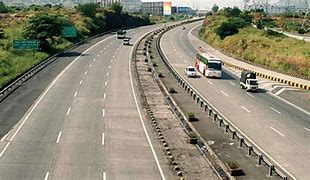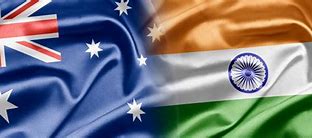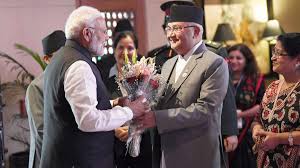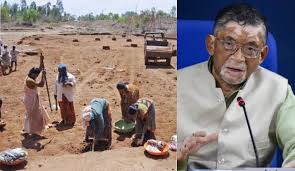Feature
Jaitley says Budget focus on welfare, infrastructure with fiscal prudence
New Delhi: Union Finance Minister Arun Jaitley on Wednesday said his Budget for 2017-18 allocates more towards rural areas, welfare schemes and infrastructure, while ensuring that government finances do not go out of control. Presenting his fourth budget in the Lok Sabha, the Finance Minister also outlined 10 themes for his latest exercise. “My approach in preparing the budget is to spend more on rural areas, infrastructure and poverty alleviation with fiscal prudence,” he said.
On demonetisation, he said it has long-term benefits and will create an economy that is bigger and cleaner. “The pace of remonetisation has also picked up and will soon reach comfortable levels. The effects of demonetisation are not expected to spill over to the next year.” He also hoped all issues pertaining to the Goods and Services Tax will be resolved soon. “GST and demonetisation are ‘tectonic’ changes for the economy,” he said.
Outlining that India has been singled out as a bright spot in the global economy by both the International Monetary Fund (IMF) and the World Bank, Jaitley said: “Inflation has been controlled, low growth has been replaced with high growth and a massive war against black money has been launched.” He said there will be a sure recovery of the economy in the next fiscal. Just ahead of the presentation, a meeting of the Cabinet presided over by Prime Minister Narendra Modi, gave its consent to the proposals.
Prior to that, the top brass of the Finance Ministry, led by Jaitley met with President Pranab Mukherjee for his approval. This is the first time the date of presentation has been advanced by nearly a month, even as it co-opts the Railway Budget into it, abandoning the practice that was started in 1924. Individual tax payers are hoping for both a hike in the exemption limit and deductions under Section 80CC of the Income Tax Act, while the industry has sought a further rationalisation of corporate tax, excise and customs duty.
Entertainment
Meghalaya Reserves Legalized Gambling and Sports Betting for Tourists

The State Scores Extra High on Gaming-Friendly Industry Index
Meghalaya scored 92.85 out of 100 possible points in a Gaming Industry Index and proved to be India’s most gaming-friendly state following its recent profound legislation changes over the field allowing land-based and online gaming, including games of chance, under a licensing regime.
The index by the UK India Business Council (UKIBC) uses a scale of 0 to 100 to measure the level of legalisation on gambling and betting achieved by a state based on the scores over a set of seven different games – lottery, horse racing, betting on sports, poker, rummy, casino and fantasy sports
Starting from February last year, Meghalaya became the third state in India’s northeast to legalise gambling and betting after Sikkim and Nagaland. After consultations with the UKIBC, the state proceeded with the adoption of the Meghalaya Regulation of Gaming Act, 2021 and the nullification of the Meghalaya Prevention of Gambling Act, 1970. Subsequently in December, the Meghalaya Regulation of Gaming Rules, 2021 were notified and came into force.
All for the Tourists
The move to legalise and license various forms of offline and online betting and gambling in Meghalaya is aimed at boosting tourism and creating jobs, and altogether raising taxation revenues for the northeastern state. At the same time, the opportunities to bet and gamble legally will be reserved only for tourists and visitors.
“We came out with a Gaming Act and subsequently framed the Regulation of Gaming Rules, 2021. The government will accordingly issue licenses to operate games of skill and chance, both online and offline,” said James P. K. Sangma, Meghalaya State Law and Taxation Minister speaking in the capital city of Shillong. “But the legalized gambling and gaming will only be for tourists and not residents of Meghalaya,” he continued.
To be allowed to play, tourists and people visiting the state for work or business purposes will have to prove their non-resident status by presenting appropriate documents, in a process similar to a bank KYC (Know Your Customer) procedure.
Meghalaya Reaches Out to a Vast Market
With 140 millions of people in India estimated to bet regularly on sports, and a total of 370 million desi bettors around prominent sporting events, as per data from one of the latest reports by Esse N Videri, Meghalaya is set to reach out and take a piece of a vast market.
Estimates on the financial value of India’s sports betting market, combined across all types of offline channels and online sports and cricket predictions and betting platforms, speak about amounts between $130 and $150 billion (roughly between ₹9.7 and ₹11.5 lakh crore).
Andhra Pradesh, Telangana and Delhi are shown to deliver the highest number of bettors and Meghalaya can count on substantial tourists flow from their betting circles. The sports betting communities of Karnataka, Maharashtra, Uttar Pradesh and Haryana are also not to be underestimated.
Among the sports, cricket is most popular, registering 68 percent of the total bet count analyzed by Esse N Videri. Football takes second position with 11 percent of the bets, followed by betting on FIFA at 7 percent and on eCricket at 5 percent. The last position in the Top 5 of popular sports for betting in India is taken by tennis with 3 percent of the bet count.
Local Citizens will Still have Their Teer Betting
Meghalaya residents will still be permitted to participate in teer betting over arrow-shooting results. Teer is a traditional method of gambling, somewhat similar to a lottery draw, and held under the rules of the Meghalaya Regulation of the Game of Arrow Shooting and the Sale of Teer Tickets Act, 2018.
Teer includes bettors wagering on the number of arrows that reach the target which is placed about 50 meters away from a team of 20 archers positioned in a semicircle.
The archers shoot volleys of arrows at the target for ten minutes, and players place their bets choosing a number between 0 and 99 trying to guess the last two digits of the number of arrows that successfully pierce the target.
If, for example, the number of hits is 256, anyone who has bet on 56 wins an amount eight times bigger than their wager.
























